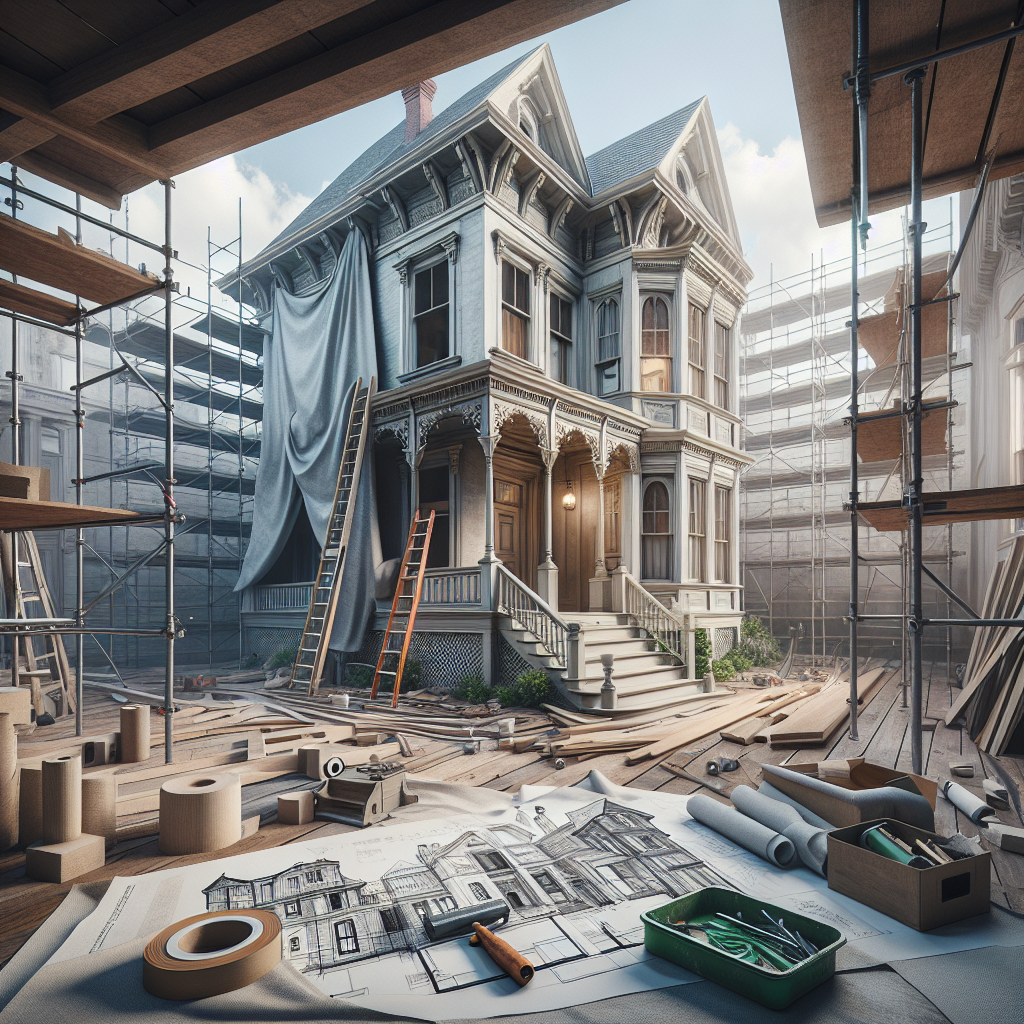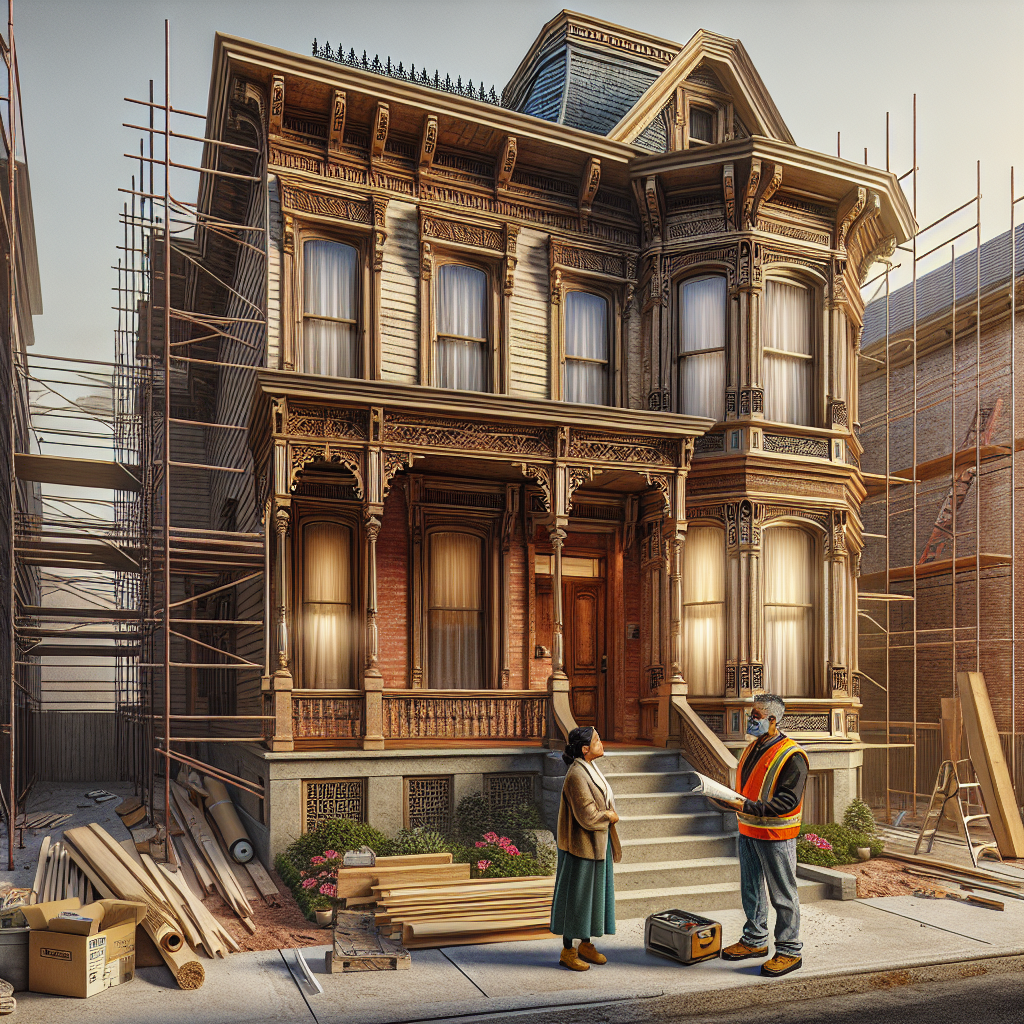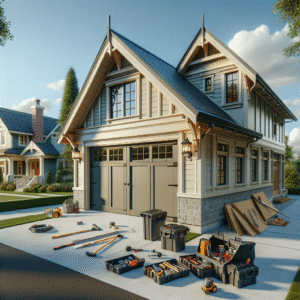Renovating a historic home is not just about preserving its aesthetics but also about respecting the history that has shaped its walls. At BuildNet, we understand the passion and complexity involved in bringing these venerable structures back to life. This guide aims to walk you through the essential steps and considerations for historic home renovation, ensuring your project respects both past craftsmanship and modern regulations.
Understanding Historic Home Renovation: Key Guidelines and Approvals
Embarking on a historic home renovation project? It’s essential to grasp the unique challenges and stringent guidelines involved. Historic homes are not only architectural treasures but also cultural symbols that require special attention to preserve their integrity. Navigating the maze of local and national preservation standards can be daunting. We’ll delve into understanding the necessary approvals and guidelines that will keep your renovation on the right track.
Top 5 Challenges in Renovating Historic Properties and How to Tackle Them
Renovating a historic property is rife with challenges, from unexpected structural issues to stringent zoning laws. However, with the right approach, these obstacles can be effectively managed or even turned into opportunities. We will explore the five most common challenges encountered during historic renovations and provide practical strategies for overcoming them.
Essential Tips for Choosing the Right Contractor for Your Historic Home Renovation
Choosing the right contractor is crucial for the success of your historic renovation project. The ideal contractor should not only have expertise in modern construction techniques but also a deep appreciation and understanding of historical preservation. We’ll offer vital tips to help you select a contractor who will honor the past while building for the future, ensuring your historic home stands proud for generations to come.

If you’re ready to take your home improvement or construction project to the next level, we can help! Find trusted contractors on BuildNet, whether you’re looking for renovations, new builds, electrical work, plumbing, or anything in between. Our directory connects you with qualified professionals who can make your vision a reality.
Understanding Historic Home Renovation: Key Guidelines and Approvals
Embarking on a historic home renovation project? That’s exciting! But, before you start dreaming about that perfect blend of vintage charm and modern convenience, let’s talk about the less glamorous, yet critical, part of the process: understanding the key guidelines and getting the necessary approvals. Navigating this maze can be daunting, but with the right knowledge, you can make your renovation journey smooth and compliant.
Why Bother with Guidelines and Approvals?
First things first, why should you even bother with all these regulations? Renovating a historic property isn’t just about maintaining its aesthetic appeal; it’s about preserving the stories and craftsmanship of the past. Local and national preservation standards are in place to ensure that renovations respect the historical significance and architectural integrity of these buildings. Plus, adhering to these rules not only protects your investment but also often uncovers financial incentives such as grants or tax breaks.
The Role of Local Historic Preservation Commissions
Most historic renovations begin with a trip to your local Historic Preservation Commission (HPC). HPCs are the gatekeepers of local historic districts, tasked with ensuring that any changes to historic properties maintain the architectural integrity of the area.
- Approval Process: Typically, you’ll need to submit your renovation plans to the HPC for approval. This process can vary significantly depending on your location, so it’s a good idea to meet with the HPC early in your planning stage.
- Guidelines: HPCs have guidelines that cover everything from the types of materials you can use to the color palettes appropriate for the era of your home. Familiarizing yourself with these guidelines before you plan your project can save you time and frustration.
Navigating State and National Regulations
If your home is designated as a state or nationally recognized historic landmark, you’ll have additional layers of oversight. These properties often come with stricter renovation standards that aim to preserve the property’s historical significance for future generations.
- State Historical Preservation Office (SHPO): Your state’s SHPO can provide guidance and necessary approvals for renovations. They typically offer resources and can help you understand the specific requirements for your project.
- National Register of Historic Places: If your home is on the National Register, any exterior changes visible from a public way generally need to be reviewed and approved. Interior changes might be less regulated, unless specific interior features are noted in the property’s registration.
Understanding the Secretary of the Interior’s Standards for Rehabilitation
At the national level, the Secretary of the Interior’s Standards for Rehabilitation are often the benchmark for any renovation project on a historically significant home. These standards focus on maintaining the historical character while allowing for some modernization for current use.
- Preserve distinctive features, finishes, and construction techniques.
- Avoid removing or altering historic materials that are important to the property.
- Updates that do not destroy historic materials are preferable.
- New additions or alterations should be done in such a way that if removed in the future, the essential form and integrity of the structure would be unimpaired.
Getting the Right Approvals
Securing approval for your renovation project can be challenging, but it’s crucial to the success of your endeavor. Here are a few tips to help you through the approval process:
- Documentation: Be prepared with detailed plans and materials that comply with the local, state, and national guidelines.
- Transparency: Keep open lines of communication with the approving bodies. Being transparent about your plans can facilitate a smoother approval process.
- Expertise: Consider hiring a contractor or architect familiar with historic renovations. Their experience can prove invaluable in both the planning and approval stages.
- Patience: Historic renovation approvals can take time. Be patient and allow for this in your project timeline.
Final Thoughts
Understanding and navigating the guidelines and approval processes for historic home renovations can initially seem overwhelming. However, with a little research, the right professional help, and a proactive approach, you can embark on your renovation journey with confidence. Remember, every hoop you jump through is part of the process of preserving the history and integrity of your beautiful historic home. So, take a deep breath, and let’s make history!

Top 5 Challenges in Renovating Historic Properties and How to Tackle Them
Thinking of taking on a historic home renovation? It’s a journey filled with the satisfaction of preserving the past, but not without its fair share of challenges. Whether you’re reviving a Victorian gem or a mid-century masterpiece, understanding these common hurdles can prepare you for a smoother renovation ride. Here’s a friendly guide to mastering the maze of historic property renovation!
1. Navigating Zoning Laws and Building Codes
One of the trickiest parts of dealing with historic properties is complying with local zoning laws and building codes. These regulations are often stricter for historic homes to preserve their structural integrity and original style.
- Tip: Before you start, visit your local building department. They’ll provide the guidelines specific to historic properties in your area. It’s also a wise move to engage a contractor with experience in historic renovations—they’ll be familiar with the nuances of local laws and codes.
2. Managing Structural Issues
Historic buildings often come with their share of wear and tear. From termite damage to worn-out foundations, the structural challenges can be daunting.
- Tip: Conduct a thorough inspection with a structural engineer who specializes in historic buildings. This upfront investment can save you from unexpected headaches and hefty repair bills down the road. They’ll help prioritize repairs that ensure the building’s safety without compromising its historical integrity.
3. Preserving Authenticity
Maintaining the authentic look and feel of a historic home is essential, not just for aesthetic continuity but often as a legal requirement by heritage preservation boards.
- Tip: Source original materials or close replicas for repairs and renovations. Salvage yards, specialized builders, and online marketplaces can be goldmines for authentic materials. Also, document all features of your home before starting work; this can help guide your restoration efforts.
4. Modernizing While Respecting History
Integrating modern conveniences like HVAC, internet, and plumbing into an old structure requires a delicate balance. You want the comforts of today, but not at the expense of losing the home’s historical character.
- Tip: Work with architects and contractors skilled in historic renovations to design modern improvements that blend seamlessly with the old. For example, they can often run new wiring or plumbing within existing walls or under floors to preserve the visual integrity of your rooms.
5. Budgeting for Unexpected Costs
Historic renovations often come with surprises—usually expensive ones. Unexpected repairs can throw your budget and timelines into disarray.
- Tip: Always allocate at least 15-20% of your total budget for unforeseen issues. It’s better to be prepared than caught off guard. Additionally, invest in comprehensive property insurance that covers any unique risks associated with historic properties.
Renovating a historic property is undoubtedly a challenging endeavor, but with the right approach and expert help, it can also be incredibly rewarding. Remember to consult professionals, respect the home’s original design, and prepare for a few surprises along the way. With these strategies in mind, you’re on track to breathe new life into a piece of history!
Essential Tips for Choosing the Right Contractor for Your Historic Home Renovation
Hey there! If you’re planning to breathe new life into a historic gem, finding the perfect contractor is crucial. Renovating a historic home isn’t just about updating; it’s about preserving its character while making it livable for today’s standards. Let’s walk through some top tips to ensure you pick a contractor who will treat your home with the respect and expertise it deserves.
1. Experience in Historic Renovations
First things first: not all contractors are cut out for historic home renovations. It’s essential to choose someone with specific experience in this area. Look for a contractor who:
- Understands the architecture: Knowledge of historical architectural styles ensures that any updates blend seamlessly with the original design.
- Knows local regulations: Historic homes often come with a set of local preservation laws. Your contractor needs to navigate these successfully.
- Has a portfolio: A good track record with before-and-after shots of previous historic renovations can give you a clear idea of their capability and style.
2. Checking References and Reviews
When it comes to renovations, word of mouth is golden. Ask your potential contractor for references specifically from historic renovation projects. Don’t just stop there—actually call these references! Inquire about:
- The quality of work and materials used
- The adherence to timelines and budgets
- Communication and problem-solving abilities during the renovation process
Additionally, scour online review platforms and local forums. Remember, a reputable contractor will be transparent about their work and happy to connect you with past clients.
3. Specialized Skills and Credentials
Historic renovations require specific skills that not every contractor might possess. Ensure your contractor has:
- Appropriate licensure: This is non-negotiable. A licensed contractor not only shows legitimacy but also implies adherence to local building codes and standards.
- Preservation credentials: Certifications or memberships in historic preservation societies can be a big plus, showing a dedicated interest and expertise in the field.
4. Understanding of Authentic Materials
Your historic home deserves the best, and part of maintaining its integrity is using the right materials. The contractor you choose should have access to and knowledge of authentic materials that match the era of your home. This includes:
- Original or reproduction fixtures and fittings
- Period-appropriate plaster, paint, and other finishes
- Techniques that align with those originally used in the home
5. Good Chemistry and Communication
You’re not just hiring skills; you’re also hiring a person. This contractor will be in and out of your home and life for months. It’s crucial that:
- You feel comfortable with them personally.
- They understand your vision for the home.
- They communicate clearly and regularly, providing updates and being honest about any challenges.
6. Detailed Contract and Clear Budget
Nothing ensures a smooth renovation process like a detailed contract and a clear, transparent budget. Ensure your contract includes:
- A detailed scope of work with what will be renovated
- A timeline for completion
- Costs itemized by materials and labor
- Information on permits and handling of potential issues
Discuss the budget thoroughly. Ensure there are stipulations for handling any unforeseen changes or challenges that could affect costs.
7. Local Reputation and Accessibility
Finally, consider a contractor’s local reputation and accessibility. A contractor who’s locally based may have:
- Strong connections with local suppliers, possibly lowering costs
- Better understanding of local architectural styles and preservation requirements
- Ease of access, making it simpler to deal with issues promptly
Choosing the right contractor for your historic home renovation can be a bit of a quest, but it’s worth the effort. By following these tips, you’ll be more likely to find a professional who not only sees the value in your historic property but can also preserve its soul while equipping it for the future. Happy renovating!

What are the basic guidelines for renovating a historic home?
Renovating a historic home requires a delicate balance between preserving the original architectural features and making modern updates. Key guidelines include respecting the original design and materials, securing necessary approvals from local historic preservation boards, and carefully planning the restoration process to maintain the property’s historical integrity.
How do I obtain approvals for renovating a historic property?
Obtaining approval for renovations involves submitting detailed plans to local historic preservation boards or committees. These plans should demonstrate how the renovations will preserve the character of the home. It’s essential to research local regulations and possibly consult with a preservation expert or architect familiar with historic renovation processes.
What are the top challenges in renovating historic properties?
Common challenges include dealing with outdated electrical and plumbing systems, restoring or replicating unique architectural details, adhering to strict guidelines set by preservation authorities, managing higher costs due to specialized materials or craftsmanship, and often uncovering unforeseen problems during the renovation process.
How can I effectively tackle the challenges of historic home renovation?
Addressing these challenges effectively requires careful planning and budgeting, hiring contractors with experience in historic properties, using appropriate materials and techniques, and maintaining open communication with regulatory bodies. Flexibility and patience are also critical, as unexpected issues are likely to arise.
What should I look for in a contractor for renovating a historic home?
When choosing a contractor for a historic renovation, look for someone with specific experience in this area. Check their credentials, ask for references, review their past projects, and ensure they understand the sensitivity required for historical preservation. It’s also vital that they communicate clearly and have a good track record with similar projects.
How do I ensure that the renovation respects the home’s historical integrity?
To ensure that renovations respect the home’s historical integrity, use materials that match the original as closely as possible, employ techniques that do not damage existing structures, and design updates that blend seamlessly with the original architecture. Consulting with preservation experts can also provide valuable insights into maintaining historical accuracy.
Are there financial aids or grants available for renovating historic properties?
Many regions offer financial aid or grants for restoring historic properties. These can come from governmental bodies, local historic preservation societies, or private foundations. Research local options and requirements as these programs can significantly offset costs and provide guidance on proper restoration practices.
What are some common mistakes to avoid in historic home renovation?
Avoid modern alterations that clash with the original style, using inappropriate or lower quality materials, neglecting to seek necessary approvals, and underestimating the time and cost required for proper restoration. Each of these can detract from the property’s value and historical significance.
How can new technologies be integrated into historic homes?
Integrating modern technology into a historic home should be done discreetly and thoughtfully. Focus on non-invasive methods that do not alter permanent structures. For example, use wireless systems for home automation, HVAC systems designed for minimal visual impact, and lighting that enhances but does not overshadow the home’s character.
Conclusion
Renovating a historic home is both a privilege and a significant responsibility. It requires a deep understanding of the property’s history, an appreciation for its architecture, and a commitment to preserving its integrity while making it suitable for modern living. Remember, each decision should enhance the property’s character, not undermine it.
Choosing the right contractor is crucial. At BuildNet, we specialize in connecting homeowners with experienced contractors who excel in the field of historic renovations. Whether you need expert advice on navigating local regulations, finding the right materials, or managing the renovation process, our directory includes professionals who can help guide your project to success. Visit us to get a free quote and start your journey in preserving a piece of history with confidence and care.







